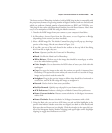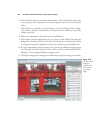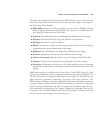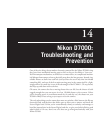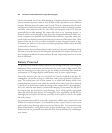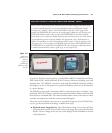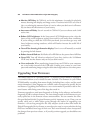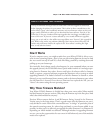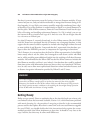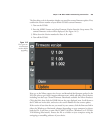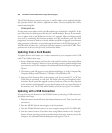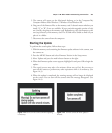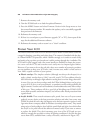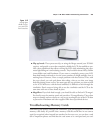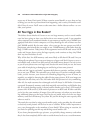
How It Works
If you’re computer savvy, you might wonder how your Nikon D7000 is able to over-
write its own operating system—that is, how can the existing firmware be used to load
the new version on top of itself? It’s a little like lifting yourself by reaching down and
pulling up on your bootstraps.
Not ironically, that’s almost exactly what happens: At your command (when you start
the upgrade process), the D7000 shifts into a special mode in which it is no longer oper-
ating from its firmware but, rather, from a small piece of software called a bootstrap
loader, a separate, protected software program that functions only at startup or when
upgrading firmware. The loader’s function is to look for firmware to launch or, when
directed, to copy new firmware from a memory card to the internal memory space where
the old firmware is located. Once the new firmware has replaced the old, you can
“reboot” the camera using the new operating system.
Why Three Firmware Modules?
Your Nikon D7000’s firmware is divided into three parts; most earlier Nikon models
had the firmware in just two sections. Why chop the firmware up in the first place? And
what’s that third module for, anyway?
Previous Nikon cameras had an A and B firmware listing, located in the Firmware
Version entry in the Setup menu. There’s a good reason why the firmware was previ-
ously divided in twain. Each of the two modules was “in charge” of particular parts of
the camera’s operating system. So, when a bug was found, or a new feature added, it was
possible, in many cases, to offer only an upgrade for either Firmware A or Firmware B,
depending on which module was affected. Although mistakes in upgrading firmware
are rare, you cut the opportunities for user errors in half when only one of the modules
needs to be replaced.
Chapter 14 ■ Nikon D7000: Troubleshooting and Prevention 463
WHEN TO UPGRADE YOUR FIRMWARE
I always recommend waiting at least two weeks after a firmware upgrade is announced
before changing the software in your camera. This is often in direct contradiction to the
online Nikon “gurus” who breathlessly announce each new firmware release on their web
pages, usually with links to where you can download the latest software. Don’t do it! Yet.
Nikon has, in the past, introduced firmware upgrades that were buggy and added prob-
lems of their own. If you own a camera affected by a new round of firmware upgrades,
I urge you to wait and let a few million over-eager fellow users “beta test” this upgrade for
you. Within a few weeks, any problems (although I don’t expect there will be any) will
surface and you’ll know whether the update is safe. Your camera is working fine right
now, so why take the chance?



